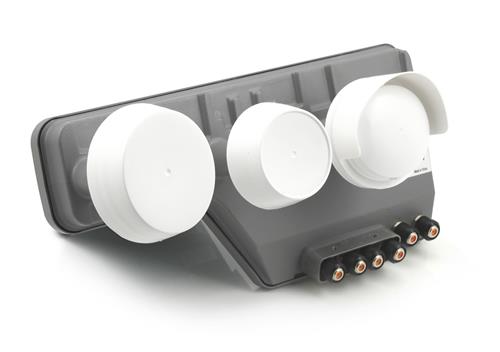If you’re a commercial DIRECTV customer, you probably know all about DIRECTV’s commercial options. However, if you’re a home user and want to upgrade your system beyond the basics, you might not be aware of what’s out there. If you go beyond just a plain-jane Genie install, you’ll probably need a multiswitch. If you want to be completely futureproof, you’ll want the right dish. So how do you do it all? This is going to take some explaining.
If you want 4K in your home, you are going to need special hardware. DIRECTV’s Reverse Band 3 LNB is a replacement for the front of your dish. It lets your dish get those extra frequencies it needs for 4K. For most homeowners, it’s all you need.
The Reverse Band 3 LNB looks at AT&T’s three primary satellite locations and receives transmissions from three different frequency ranges. (The older LNB only receives transmissions from two, that’s the difference.) It gives you the ability to feed 13 tuners consistently, and if you’re careful with how you power up, you can feed up to 21 tuners.
(Confused about what that means? Here’s a tutorial.)
That should be enough for everyone, right?
What if it isn’t?
If you have a large home and you want 4K, you’re going to have an HR54 Genie DVR, a 4K client or Gemini, several Genie Mini Clients, and a mix of other receivers. You’ll get past that 13-tuner limit pretty quickly and unless you feel comfortable with a very careful powerup sequence, you’ll run into trouble getting up to 21 tuners.
In order to get past that 13-tuner boundary, you’ll need an external SWM module. The right choice is the SWM-30, which will distribute 4K and HD to up to 26 tuners in your home. In a commercial setting, using commercial-only receivers, it will serve up to 30 tuners, hence the name.
The SWM-30 accepts 6 lines in. Older multiswitches only needed four lines in, but the new frequencies require two more lines. The Reverse Band LNB has one line out. So how do you do it? How do you connect a Reverse Band LNB to a SWM-30?
Easy answer: you don’t.
SWM-enabled LNBs cannot connect to external SWM modules. This isn’t a new thing: I famously wrote about it a few years ago before Reverse Band LNBs even came out. Luckily though there is a solution for people who want to be completely futureproof and also want to have a lot of receivers in their homes.

This is the Reverse Band Legacy LNB from DIRECTV. It will receive broadcasts from all of DIRECTV’s satellite locations and will receive all the different frequency ranges. It features six outputs, which correspond to the six inputs on the SWM-30. Problem solved.
When installing this LNB, it should be a fairly easy swap-in for the Reverse Band 3 LNB. You may need to do a bit more aiming, though. This LNB is designed to see DIRECTV’s 119 location, which most people do not actually need. However, there isn’t an LNB that puts out six lines and only sees the three primary location. That may happen in the future but it’s not here yet. If you don’t aim at the 119 location, you may see errors pop up. The AIM meter will help you get a perfect result every time. Once you finish aiming, connect the lines to the SWM-30 and you’re set. The other two lines generally run outside the feed arm, and commercial installers generally use zip ties to connect the outer two lines to the arm.
Lines 1-4 connect to any of ports 1-4 on the SWM. You must connect the fifth line from the left to the fifth port on the SWM. Similarly, you must connect the sixth line to the sixth port. Keep that in mind and you’ll be fine. The easiest thing to do is to make sure you label the lines when you’re running them.
Learn all this and more
You’ll find a complete guide to installing a Reverse Band Legacy LNB as well as tons more in our e-book, “The Ultimate Guide to Upgrading Your DIRECTV System.” In one volume, you’ll get parts lists, diagrams, and helpful advice. Hundreds of thousands savvy DIYers use it, and it’s a favorite of installers too! If you still need help, call the experts! Our tech team is here for you at 888-233-7563 during East Coast business hours. If it’s after hours, just fill out the form below.





